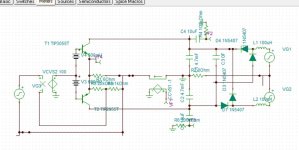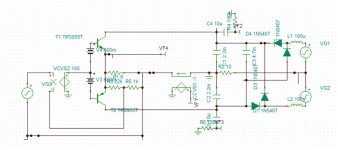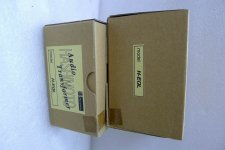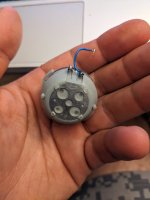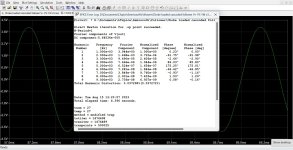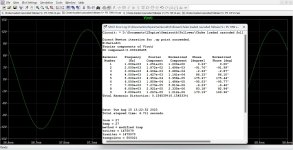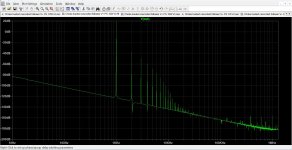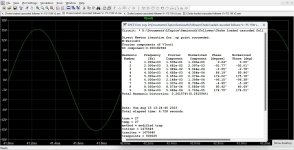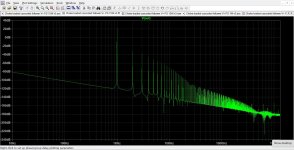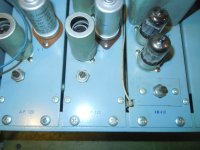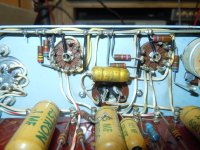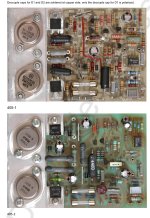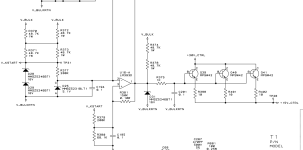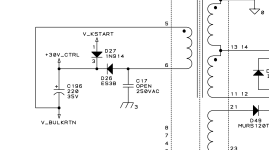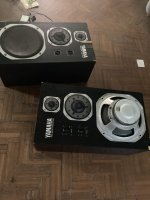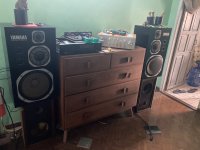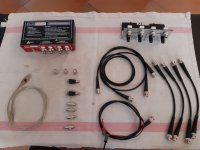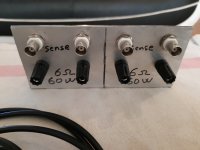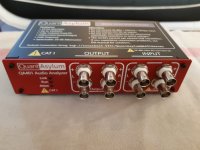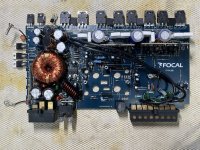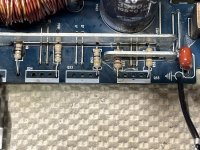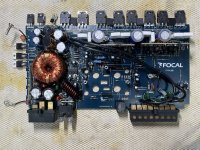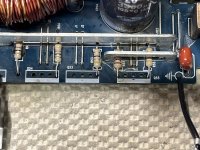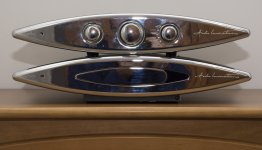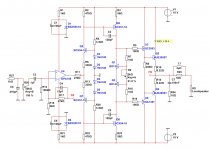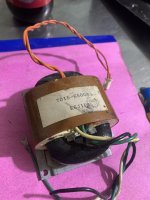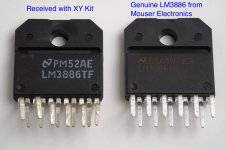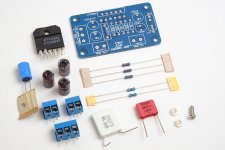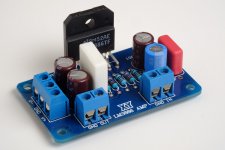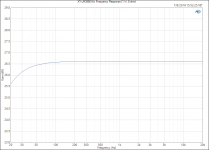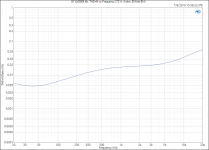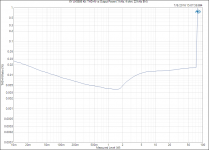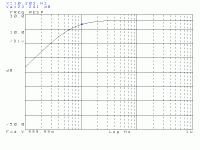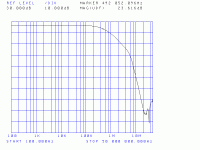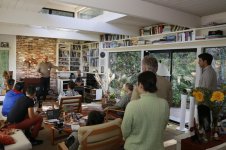O2 headphone amp output booster and upgrade PCB
EDITED and updated 1/21/2017. The latest V3.6 layout, schematic, BOM, part ID diagram and build instructions for this project are at a Google Drive link here:
https://drive.google.com/folderview?id=0B67cJELZW-i8Vmp5MDVLNzJxTGc&usp=sharing
Then the "V 3.6 1_28_2017" folder.
PC boards are available. To order a board see my vendor forum link:
http://www.diyaudio.com/forums/vendors-bazaar/293309-agdr-audio-sales-thread.html
The final circuit uses the OPA140 or OPA827 (OPA827 is recommended) op-amps (FET input, DC precision, low THD+N) looped around an LME49600 audio current buffer on each channel to replace the O2 Headphone Amp's original NJM4556A output chips. The board produces a 93% reduction in the O2 amp's DC output offset voltage to around 20uV from the O2's standard 3.6mV, if using the recommended OPA827 chip. Output current capability is increased from 120mA per channel to 250mA for peaks - "music power" - playing music rather than sine wave testing. The O2's power supply has limitations that would prevent continuous current draw above 200mA per channel. The Booster Board adds: a headphone relay for zero turn-on or turn-off thumps; power rail reverse clamp diodes; and true zero ohm output impedance if the O2's 1R resistors are jumpered across.
PLEASE NOTE: I highly recommend using no higher than a 12Vac transformer with NwAvGuy's O2 headphone amplifier, givne the lack of heat sinks on the O2 voltage regulators. That goes for O2's with or without a Booster Board. You want at least a 12Vac 500mA transformer like a Jameco #101258. With the Booster Board the ideal transformer is the 12Vac 1amp (1000mA) Jameco #10081 for $1 more due. More than 1 amp wouldn't buy you anything additional.
There are several older versions of the board discussed in this thread, starting with the initial idea in the rest of this post below the asterisk line, leading up to the most recent V3.6. The project files for the older of these are under the "archived older versions" folder.
V3.5 changes
I corrected a bug in the older versions that caused the DC output offset to go up to O2 "regular" O2 headphone amp levels, around 3mV, when the volume pot was turned all the way down. The bug shouldn't have caused any audible problems for anyone since it only happened with the volume control rotated to the very extreme low position - no sound coming out. Now with V3.5 and above the DC output offset is the same ultra low 20uV even with the volume control down.
I moved the 1 meg ohm resistor that has previously been soldered in series with the sense wire that solders to the O2 board onto the Booster Board. The type of SMD diode for the relay was changed to 1A from the previous 3A, which was excessive. Placeholder pads (zero ohm resistors currently) have been added in series with the inputs to the LME49600, in case some other type of op-amps (other than the OPA827 or OPA140) require them. The RC power rail filters in series with the OPA827 power leads have their BOM values lowered from 100R to 1R. The previous value was set to coincide with the chip's datasheet PSRR drop. The new value sets the corner frequency at 72KHz, above the audio range.
The direction of the connection pins has been reversed from previous version in the build instructions, with the black plastic bar now up towards the Booster Board. The connection pins work fine either way, but one person using non-BOM IC sockets in their O2 had found that the pins fit best with the bar side up. I've also added wording in the build instructions to make sure the connection pins are centered top to bottom in the IC sockets if using the non-collet socket option in the O2 BOM, when soldering up the pins. The non-collet sockets have wide flat sockets for the IC pins which can allow 0.5mm or more of front to back placement. If the connection pins are not centered in the U3 and U4 sockets when soldering them they work perfectly fine, but one or both sets of will be at something like a slight 5 degree angle front-to-back.
The front panel green LEDs and their series resistors are now listed as "optional" in the BOM since most people have chosen not to install those. They have no circuit function other than just quick indicators to show the O2's power rails are OK (one LED on each power rail). They require two new small holes be drilled in the O2 front panel to see them, although the panel will clear just fine even without holes. Plus they cause a tiny amount of additional battery drain. There is a CAD file for a new O2 front panel with the LED holes at the Google Drive link above.
V3.5 was fabricated at a board house that allows the extra 2mm of board length needed to get all the connection pins onto the board, for the same price. Previous versions had the bottom two connection pins of U4 sticking out past the board (unused anyway) since the prior board house only allowed 50mm without a big price increase.
V3.6 changes
The left and right sides of the "tab" section are moved slightly, both 1mm to the left. This gives a little more room if a person has used non-BOM filter capacitors in their O2 which are slightly bigger diameter (one fellow ran into this with his Booster). Rectangular silk screen outlines have been added around the connection pin holes on the bottom of the board as a reminder to use the plastic-bar end of the pins up toward the Booster.
Placeholder pads added (currently un-populated) for bandwidth-adjust resistors for the LME49600 chips. The LME49600s are normally run in low-bandwidth mode (110MHz) since it is adequate for the OPA827 (or OPA140), pulls less idle current and produces less heat. But if someone has a situation where their specific headphones cause oscillation (very rare) the 100R bandwidth resistors can be added to bump the LME49600 up to high-bandwith 180MHz mode, for increased phase margin.
***************************************************************************
Sergey888 - I had an idea today for your OPA551 + linearization chip 2nd order circuit.
😀
Turns out there is a open strip of space in RocketScientist / NwAvGuy's standard O2 headphone amp above all the front components that is 28mm deep and the 80mm case width. A circuit board slid into the top slot there clears all the components and mounts perfectly between the battery connectors in the rear and the front panel. The is 5.5mm of free space from the top of the PCB surface, inserted into that top slot, and the top of the standard B2-080 case.
So here is your OPA551 circuit + linearization op amp layed out on a board that fits that space in the O2. I've left the area above the noisy AC input parts blank. The board connects to the O2 by using twisted pair wires going to DIP8 headers that plug into the IC sockets where the NJM4556A chips go. In other words, just pull out the two NJM4556A chips from the sockets, plug in the two headers like this one (Mouser #535-08-600-21)
08-600-21 Aries Electronics | Mouser
slip the board into the O2 B2-080 stop slot and away it goes! Well almost. One twisted pair of wires go to one NJM4556A socket header plug (input/output, signals in phase), 4 to the other (V+, V-, input/output signals in phase) but then one additional wire has to be soldered to a ground point such as the middle hole of the output jack connector. There is no ground present in the NJM4556A chip holes.
A few potential benefits of the OPA551 output chips vs. the NJM4556A chips:
* Potentially lower distortion given the loop with the LME49990 chip. I substituted the LME49990 for the LME49860 since no voltage higher than +/-15Vdc rails is needed anymore and the 49990 specs beat the LME49720/49860 slightly.
* One single OPA551 vs. the two paralleled sections of the NJM4556A on each channel. No paralleled outputs anymore. The 1R output resistors are no longer needed, no output resistors at all in fact, unless I run into reactive load oscillation issues during testing.
* Higher output voltage capability by 3Vdc peak! The 12Vdc voltage regulators in the O2 can be replaced with 15Vdc regulators (LM7815 / LM7915) and with a 16Vac or 18Vac input you now have +/-15Vdc rails.
😀 Looking through the voltage specs of RocketScientist's capacitors I think that I only saw one that has to be bumped up to a higher voltage. The LME49990 is not only specified at +/15Vdc, it is specified at 18Vdc. The OPA551 is good with either rail voltage too, of course. The existing +/-12Vdc regulators in the O2 can still be used too, of course. No requirement to go with a higher rail voltage.
* More power dissipation. I pitched RocketScientist once on bumping up the rail voltages to +/-15Vdc. He correctly noted that would push the NJM4556A's over their maximum power dissipation under some circumstances. No such problem with the DPAK OPA551's.
* It all fits, I think. The OPA551 is apparently 4.5mm thick and there is 5.5mm of free space above the board. We'll see what happens when it is soldered down with the solder film thickness. I've used 1206 surface mount for everything else.
* Short circuit protection form the TRS is maintained with the (short circuit protected) OPA551.
* Potentially higher current output. The OPA551's are good for 200mA each vs. about 120mA for the paralled NJM4556As, but I'll have to do some power dissipation calculations on the heatsink foil area and on the un-heatsinked regulators in the O2.
* Still battery power friendly for portable use! The quiescent current draw of the OPA551 at 8mA is about the same as the 9mA of the NJM4556A's they replace on each channel, a wash. So the added current draw from the batteries are just the LME49990's on each channel at 8mA each.
* Noise, or lack of it, may be about the same. 14nV/sqrt(Hz) for the OPA551 vs. the RMS sum of 10nV/sqrt(Hz) for the two parallel sections of the NJM4556A, which happens to also equal 14nV/Hz. The distribution over the higher frequencies is not the same though and the tiny 0.9nV/sqrt(Hz) of the LME49990 is added plus some additional resistor Johnson noise.
A lot more layout work to do, plus I need to add the bypassing. But it looks like it all may fit.










